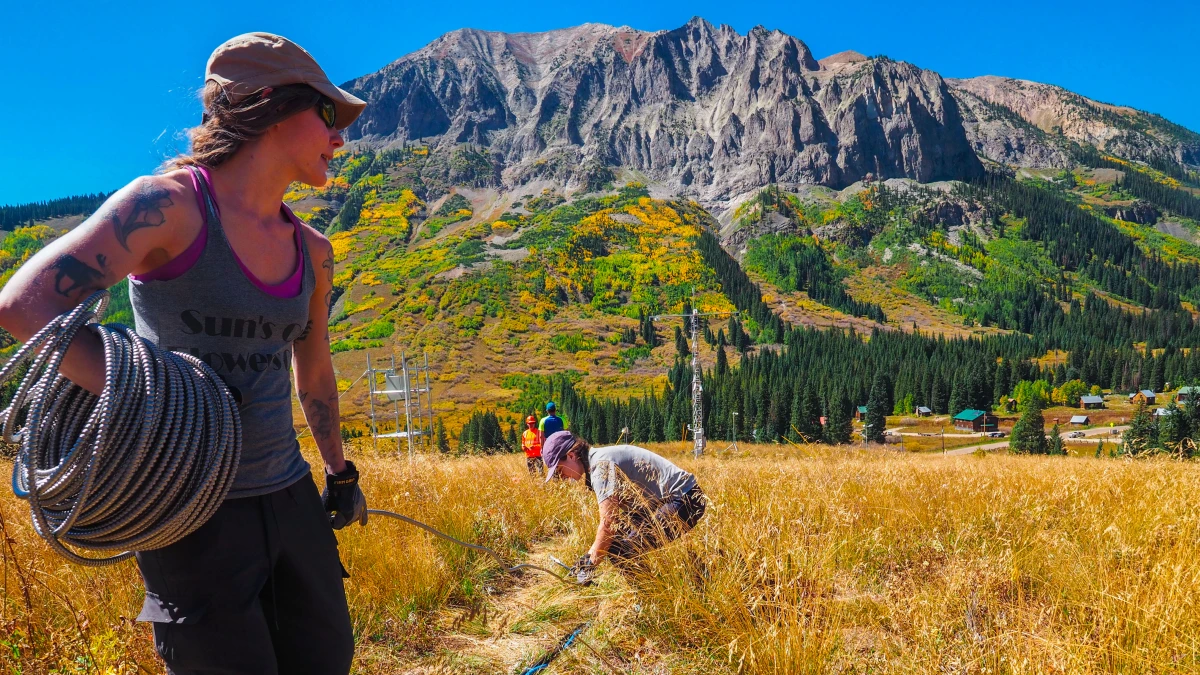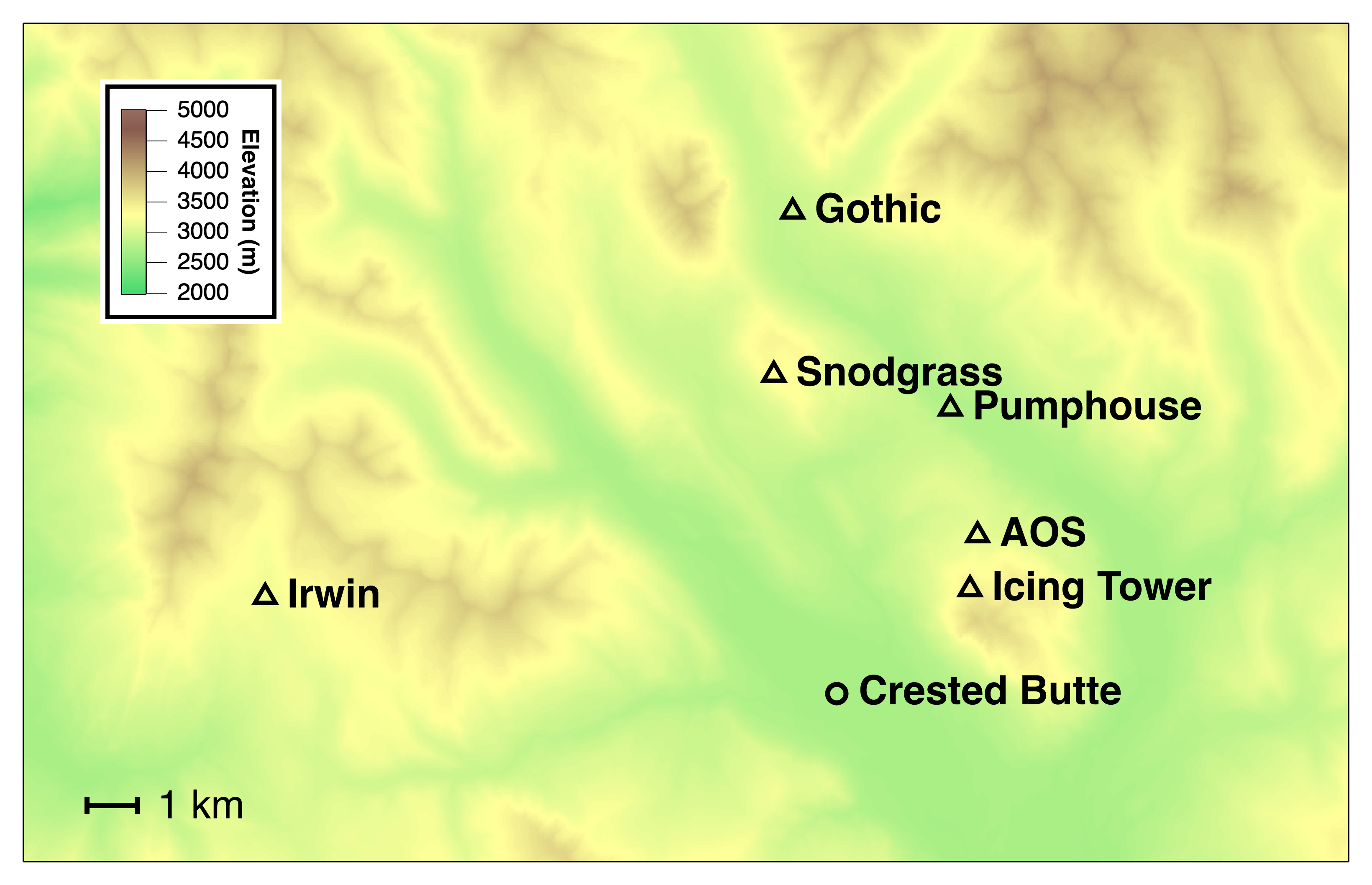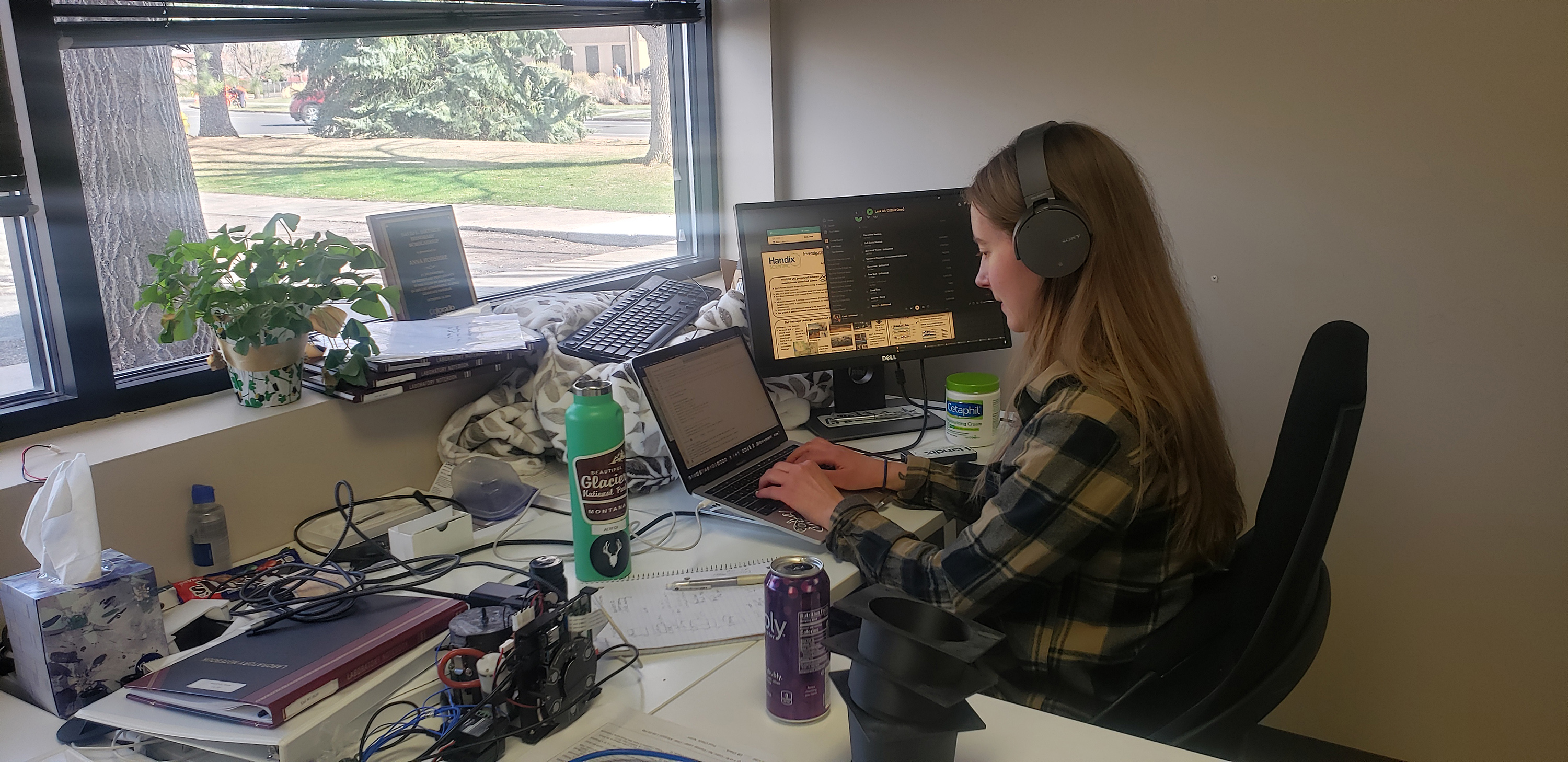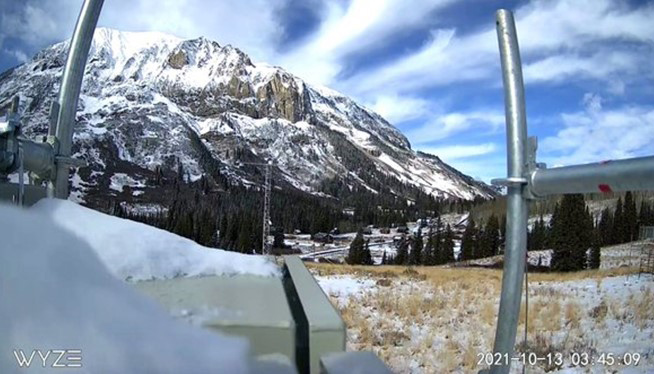An early career atmospheric scientist joins an ASR-funded hunt for aerosols in complex mountain terrain

Anna Lily Hodshire is an associate scientist at Handix Scientific, Inc. in Fort Collins, Colorado. The firm designs and develops cloud and aerosol probes. That fits nicely with this student of cloud-aerosol interactions who sees cloud nuclei “as just about my favorite topic ever.”
For proof, check out Hodshire’s very active Twitter feed, @AirHods, which praises a recent INP paper. Her tweets also range widely, from knotty equations and particle filters to presentations and science writing.
That last, says Hodshire, “is a reflection of my own pain.”
Cloud nuclei are ultrafine solid and liquid particles in the atmosphere that make clouds and precipitation possible.
Not long ago, Hodshire and a few colleagues deployed six arrays of miniaturized instruments in a remote mountain valley in Colorado, not far from a onetime ghost town named Gothic.
The instruments are one note in a symphony of measurements during a U.S. Department of Energy (DOE) field campaign called Surface Atmosphere Integrated Field Laboratory (SAIL).
SAIL is a long-term, all-season study of the bedrock-to-atmosphere factors that influence mountain hydrology. Stores of snowpack and seasonal rains are the water towers of the Colorado River Watershed in the American West, where 40 million people depend on its high-altitude sources for fresh water.
Cloud nuclei and other aerosols are one of those factors.

The campaign’s core instruments are supplied by the Atmospheric Radiation Measurement (ARM), a DOE Office of Science user facility that operates fixed and mobile observatories across the world. Some of SAIL’s funding comes from DOE’s Atmospheric System Research (ASR) program. So does the funding for the Handix project, SAIL-NET, led by Ezra Levin.
Aerosol-Cloud Interactions
Hodshire was working on a postdoctoral research position at Colorado State University when Levin approached her in 2020 to help apply for ASR funding.
“I knew the framework” of the application process, says Hodshire.
Under the eye of Delphine Farmer, an ASR funding veteran, her postdoctoral research at Colorado State University (M.S. 2016, PhD 2019) was a Sloan Foundation project on indoor-air trace gases.
Levin’s 2021―2024 ASR project required “a 180-degree turn” from indoor air,” says Hodshire, and it took her into the outdoors. The SAIL-NET mission is to gather aerosol-cloud interaction data in a mountain setting.
“We had a vision of using miniaturized, mid-cost instruments in a measurement network in complex terrain,” says Hodshire, who had not done fieldwork before. “We wanted to see if there is value to having increased spatial information.”
SAIL-NET arrays are already deployed within a grid of 10 by 15 kilometers (6 by 9 miles). One set is co-located with ARM SAIL’s main aerosol observing system (AOS) in Crested Butte, Colorado. Others are in low valley terrain, and some are high up, including one on the top of Crested Butte, SAIL’s highest-elevation instrument site.
Each array includes two counters―one for cloud condensation nuclei (CCNs) and another for particle size distribution measurements. In addition, a specialized filter collects aerosol samples.
Pucks and POPS

The CCN device, called a CloudPuck, is a Handix instrument now in beta testing. It pulls air into a chamber about the size of a hockey puck. The chamber has wetted plates that create a supersaturation profile. Any CCN pulled into the chamber activate into droplets and are counted.
Another Handix instrument at work during SAIL is the portable optical particle spectrometer, or POPS. Drawing less than 15 watts of power and smaller than a shoebox, POPS can accurately measure the diameters of particles down to a fraction of a nanometer. It is already standard gear on ARM tethered balloon systems (TBS).
The device for collecting INP samples was reported in 2018 by atmospheric scientist and Arctic veteran Jessie Creamean. She is one of two ARM aerosol mentors at Colorado State.
First developed for aerial measurements, the device has a miniaturized filter sampler cartridge that rotates to capture fresh samples for SAIL every 48 hours. (It can also be programmed for different collection intervals.)
After collection, however, distinguishing which particles are INPs “is the challenging part,” says Hodshire. It must be done on in a laboratory, using equipment such as ice spectrometers at Colorado State.
Handix is using DOE funding to develop an INP counter that uses microfluidics technology to speed up analysis―someday even in the field, aboard tethered balloons or uncrewed aerial systems.
The Vertical and the Various
Levin, Hodshire, and others are using the field portion of SAIL-NET to take measurements of cloud and aerosol properties that complement other SAIL instruments.

They are also asking: How do aerosols and cloud nuclei vary within a range of vertical variations? How do such particles vary across space and time? And how good are small, networked instruments in answering such questions?
Hodshire says the ASR project is the first of its kind to deploy such sensors across a small patch of mountain-and-valley terrain. The hope is that the work will add another facet of knowledge to the bigger SAIL mission―to better understand the hydrologic cycle in such critical mountain terrain.
The ASR project also fits right into how Hodshire, in part, sees herself: a scientist interested in “creating flexible and intelligent instrument ecosystems for sampling atmospheric properties.”
Moose, Marmots, Memories
Joining SAIL-NET comes with a cost, including winter travel to the site, five hours west of Fort Collins. Hodshire did two tours in the fall of 2021, joining installation teams for a week in September and one in October.
“It was physically hard,” she admits.
Each site required carrying close to 300 pounds of steel scaffolding, along with solar panels whose batteries weighed about 40 pounds each. One site is 2.5 miles off the main trail. The panels must be mounted high to accommodate snowpack levels that reach 10 feet or more.
There are also rotations for members of the Handix team to do monthly sample collections and calibration runs. In 2022, Hodshire drew the February and March straw.
Still, along the way, Hodshire tweets about snow adventures with her rambunctious pup Mac, and a growing fondness for mountain lupin flowers and marmots―the pot-bellied squirrel relatives who sun themselves on high-elevation crags.
“I have a lot of fun” with aerosol work, says the #GetOutside fan, who is also a fair-weather hiker, summer kayaker, and cross-country skier.
Any physical challenges related to the mountain-terrain ASR project are justified by being able to escape her desk, says Hodshire. “I work at my computer a lot.”
Layers of Inspiration

Hodshire grew up in Ogden, Utah, in the foothills of the towering Wasatch Mountains. It was a place that afforded layers of inspiration for someone bound to do science.
The landscape was one inspiration―a display of natural beauty worth protecting.
“I never had to look” for nature, says Hodshire of the unwitting scientist she was as a girl. “It was always there.”
Then there was a flipside to the beauty: the terrible air inversions that lowered and colored the winter sky. As a college student, Hodshire wondered about them during her three-mile walk to school and back.
Her parents, both polymaths with a taste for the outdoors, were also inspirations. They embraced curiosity and processed endless banks of eclectic knowledge. Her father trained as a zoologist, wrote screenplays, and laid concrete for parking garages. (He died while Hodshire was in high school.) Her mother trained as a lawyer, settled on teaching English composition, and writes poetry.
They gave her the gift of music too. Hodshire plays the flute, saxophone, piano, and bass guitar. Though she is too busy for a band now, she spent some time at home during the pandemic composing and performing her own music.
In school, from the elementary grades onward, “teachers would encourage me to stretch more,” says Hodshire.
Those nudges to academics led her away from her earliest career aspiration, which was to be an audiobook voice talent. AP chemistry in high school was another nudge.
“This is extremely valuable and very hard,” she remembers thinking. “I want to know more.”
‘The Big Picture in My Heart’
Not far from home, at Weber State College (B.S. in physics and applied math, 2014), Hodshire says finding a deep interest “was a slow burn.”
She started in engineering before moving on to a major in physics. In her fifth year (a double major in math takes extra time), Hodshire was applying to graduate physics programs. Then her physics mentor John Armstrong asked, “Have you ever heard of atmospheric science?”
Hodshire thought to herself, “What is this strange world I have never heard of?”
Well, a world that seemed both rigorous and useful. “Measuring,” as in physics, she thought, “is not solving.”
A world that would put her physics and math training to work. One that would turn her interest in chemistry to the atmosphere and perhaps answer the puzzle of those air inversions.

“The big picture in my heart,” says Hodshire, “is that I want to do something about air pollution.”
Hodshire tore up her graduate school applications for physics programs and wrote to schools focused on atmospheric science. She landed at Colorado State, one of the best.
The Draw of Particles
At Colorado State, “it was a pretty smooth transition” from physics to atmospheric chemistry, says Hodshire. “It was also a positive transition, since it allowed me to (part with) what I did not like about physics,” including an emphasis on theory over action. “I wanted something more concrete.”
As for focusing on aerosols, she adds, that was “a little bit of the luck of the draw.”
Her master’s and PhD advisor, professor of atmospheric science Jeff Pierce, had funding in place for aerosols research. That led Hodshire to specialize in a practical blend of physics and chemistry called aerosol microphysics.
Also, a big help along the way for “a very shy beginner,” she says, was research scientist Bonnie Ford Hoffman.
With Pierce guiding the way, Hodshire wrote a master’s thesis on new-particle formation events, in part based on a DOE-funded collaboration with ultra-fine aerosols expert Jim Smith at the University of California, Irvine.
Aerosol microphysics also informed her dissertation on the fate of particulate matter within wildfire smoke plumes. She asked: How do such particles evolve downwind? What effect do they have on how sunlight is scattered and absorbed?
The work was a form of closure for the one-time schoolgirl who was once struck by atmospheric inversions in Utah. They are, she reflects now, largely the result of particle transport.
A View from Industry
Hodshire joined Handix in 2021. After her years in academia, the experience has given her a view of science from the industry side.
“So many things have been thrown at me at Handix,” she says gratefully. “I am rapidly reimaging my identity in science.”
Her industry-side view included two months of training with DOE’s Energy I-Corps, which provides a framework for private companies to collaborate with federal research partners.
Handix is also open to Hodshire’s consistent inclination to mentor, which started a decade ago as a physics, math, and chemistry tutor at Weber State.
Today, she is in her eighth year of guiding women in the early stages of studying the geosciences in college. It’s part of a women-in-STEM program funded by the National Science Foundation called PROmoting Geoscience Research, Education & Success (PROGRESS).
Hodshire is also a volunteer with Skype a Scientist, which connects experts to classrooms worldwide, from first grade through junior year in high school.
“It’s very rewarding. I’m always blown away at the questions they ask,” she says, including queries on climate change and pollution. “Fantastically bright questions.”
Being online with young students reminds Hodshire of the moment she learned there was such a thing as atmospheric science.
Back then, Hodshire said to herself: “Thank goodness for other people who know a few things about the world.”
# # #Author: Corydon Ireland, Science Writer, Pacific Northwest National Laboratory
This work was supported by the U.S. Department of Energy’s Office of Science, through the Biological and Environmental Research program as part of the Atmospheric System Research program.

